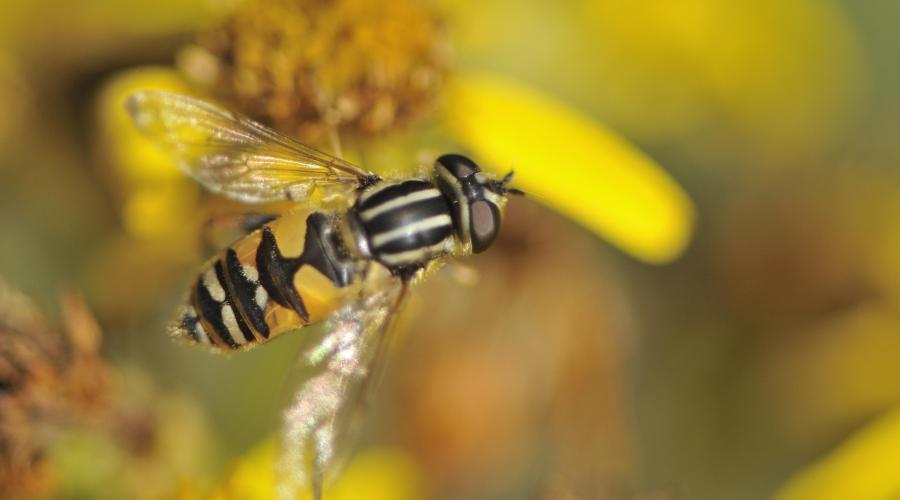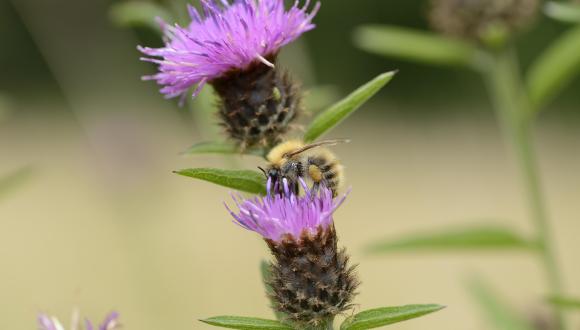
Swarm of support for Scotland’s pollinators
21 February 2024
People around Scotland are doing more than ever to help save threatened bees, moths, and hoverflies, according to a new NatureScot report.
From creating wildflower meadows and green corridors, to carrying out bumblebee surveys and mowing less, local authorities, environmental bodies, scientists, communities, and individuals are taking action to help boost pollinator populations.
The Pollinator 2023 Progress Report finds that almost every local authority in the country is now carrying out a range of pollinator activities to support the aims of The Pollinator Strategy for Scotland. And the wealth of activities recorded over recent years shows that, from the Northern Isles to the Scottish Borders, there is growing commitment to pollinator-friendly practices.
NatureScot Pollinator Strategy Manager, Jim Jeffrey said:
“This swell of support is much needed at a time when many species of bees, hoverflies and moths are facing population declines due to changes in land use, habitat loss, diseases, pesticides, and climate.
“We rely on these insects to pollinate many of our crops and wild plants so it’s encouraging to see local authorities, environmental groups, communities and schools coming together to help these vital insects.”
This sixth annual report details the progress being made by a wide range of groups and individuals to make Scotland a place where pollinators thrive. Some of the pollinator-friendly work in 2023 includes:
- Pollinators Along the Tweed, a partnership between Buglife, Tweed Forum and Scottish Borders Council, is creating and restoring 40 hectares of wildflower-rich habitat. Working across 50 sites in towns and villages along the Tweed, as well as the wider countryside, this project will help restore habitat connectivity for pollinating insects, helping them to better move across the landscape and adapt to a changing environment.
- Led by the Scottish Wildlife Trust, the Irvine to Girvan Nectar Network is a creating corridors of pollinator-friendly green spaces along the Ayrshire Coast, ensuring the long-term survival of the area’s pollinating insects. The project is using innovative cutting techniques to harvest ‘green hay’ to create new wildflower meadows from the cuttings and seeds of their existing meadows.
- The Highland Wildflower Meadow Mosaic has, so far, seen the creation of 91 pocket meadows across northern Scotland, led by the High Life Highland Countryside Rangers working with volunteers and schools, and by many other communities and individuals.
As well as local efforts, significant conservation projects are taking place across Scotland for the benefit of pollinators. Species on the Edge, a ground-breaking new partnership programme of NatureScot and seven nature conservation charities, is working to secure a future for 37 priority species found on Scotland’s coasts and islands. Within those, there are several pollinator species.
Bees on the Edge helps the great yellow bumblebee, moss carder bumblebee and northern colletes mining bee, while Rockin’ the Blues works to support the small blue and northern brown argus butterflies. A Brighter Future for Herb Rich Pastures focusses on marsh fritillary and four rare burnet moth species found on the west coast of Scotland and the Inner Hebrides. Project teams provide practical support, habitat improvements and monitoring to better understand the species’ needs while providing training and other support for local communities to do all this themselves and empower them to become directly involved in conservation.
Although great progress is being made, there’s always more to be done, as Jim continues:
“We’re heading towards early spring, which can be tricky for insects, particularly those emerging from hibernation. Having pollinator-friendly plants flowering in your garden from March on provides them with a vital food source.
“You can also help monitor the health of our bees, moths, and hoverflies by taking part in the UK Pollinator Monitoring Scheme between April and September. We can all do something positive for pollinators.”




